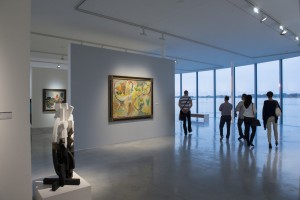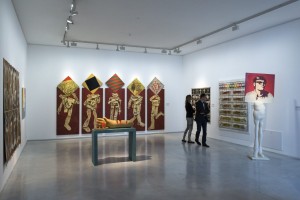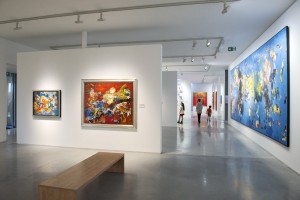A permanent exposition is an important element of every collecting institution, and the Danubiana was expanded for this very reason – to provide space for a permanent presentation of our collection of international and Slovak art. We must emphasize that this exposition with its international nature is a true breakthrough, because a similar type of exposition of contemporary (post-war) international art simply didn’t exist in Slovakia. This is due to the fact that museum and gallery institutions had no possibility of acquiring modern and contemporary artwork during the previous regime because it was considered anti-Socialist.
The artwork featured in this exposition comes from two sources. Most of the pieces are from the collection of Gerard Meulensteen, who provided them to the museum on loan; the smaller part is from the Danubiana collection. Thus, the exposition from the Meulensteen collection fills the gap in the presentation of international art in our country and provides visitors with access to the artwork of certain outstanding figures of international significance.
The exposition is comprised of an international collection, a collection of Dutch art and a collection of Slovak art. Sam Francis, from the second wave of American abstract painting, dominates the international set and the collection of his paintings was given a separate space. The presentation of the work of Christo and Jeanne Claude, Paul Jenkins, Jill Moser, and from the younger generation, Oliver Herring, is also extraordinary.
The Meulensteen Collection, which was not built from the art historical aspect and thus does not pursue development contexts, contains individual paintings by excellent artists. The collection of Austrian artists, Hermann Nitsch, Karl Prantl, Hannes Mlenek and Günter Damisch is a good example. The works of Ilona Keserü Ilona, Dora Maurer and István Nádler, Hungarian avant-garde painters of the 1960s, is equally representative. The international mosaic is completed by the works of outstanding figures such as Miguel Ybanez from Spain, Robert Combas, the French painter of the figuration libre movement, and the expansive photographer Gérard Rancinan. Globetrotter Kiro Urdin, Miloš Sobaić, a Serbian artist of extraordinary expressive power and Chinese artist Walasse Ting also belong to this group.
The quality presentation of Dutch artists, especially from the CoBrA avant-garde group, deserves special attention. Karl Appel’s excellent collection includes one of his last paintings, while the names of the other artists: Pierre Aleschinsky, Constant, Corneille and Ad Snijders are reminders of the greatness of the avant-garde output of that period.
The inclusion of a collection of the work of Slovak artists in this international context is not an everyday occurrence, but its top expressions comprise a comparable platform. The fundamental idea to create backbone collections of important Slovak artists, namely Miroslav Cipár, Rudolf Fila, Jozef Jankovič and Rudo Sikora established an appropriate qualitative level. The individual works of other artists such as Viera Kraicová, Rudolf Uher, Milan Paštéka, Alojz Klima, Vladimír Kompánek, Vladimír Popovič, and, from the younger generation, Ladislav Teren, Ivan Csudai, Peter Pollág, Dorota Sadovská, Marek Ormandík, Erik Schille and others confirm the creative viability of contemporary Slovak art.
The exposition in the museum interior is complemented by the presentation of sculptures in the park, and we are grateful to Gerard Meulensteen who provided the constructivist sculpture by El Lissitzky on loan. This is a truly unique and exceptional work of art.









